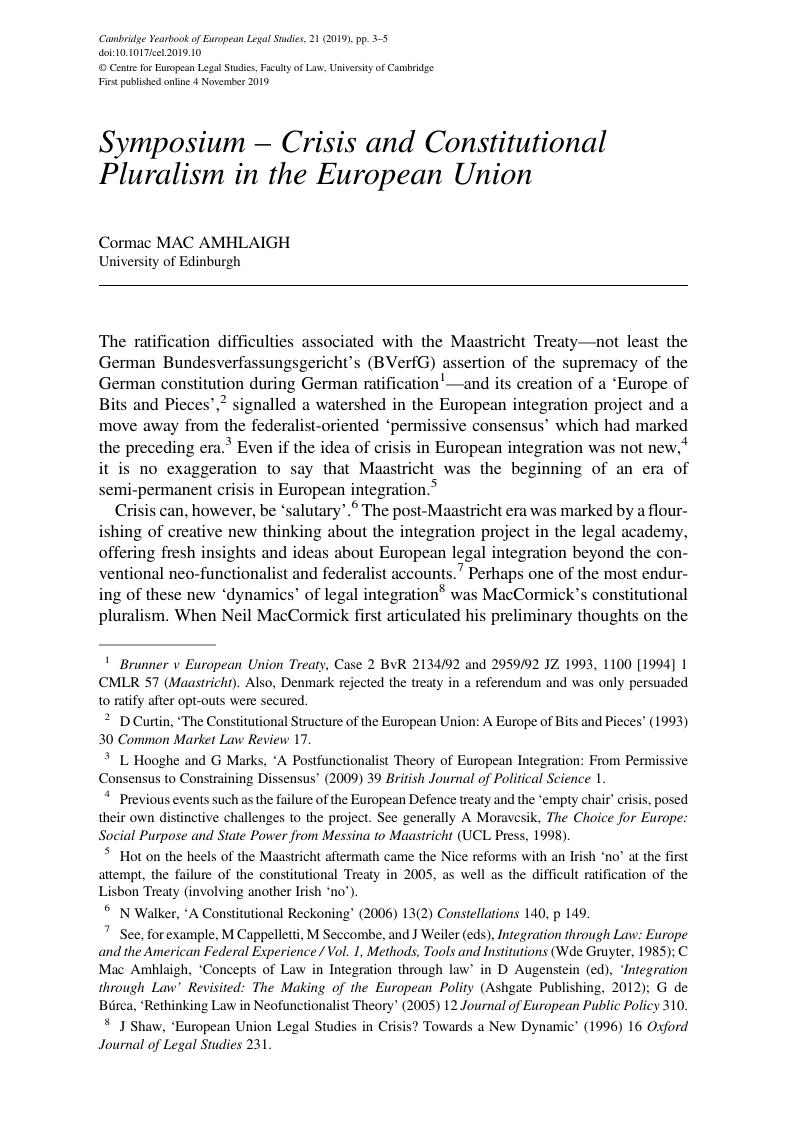Article contents
Symposium – Crisis and Constitutional Pluralism in the European Union
Published online by Cambridge University Press: 04 November 2019
Abstract

- Type
- Symposium
- Information
- Copyright
- Copyright © Centre for European Legal Studies, Faculty of Law, University of Cambridge
References
1 Brunner v European Union Treaty, Case 2 BvR 2134/92 and 2959/92 JZ 1993, 1100 [1994] 1 CMLR 57 (Maastricht). Also, Denmark rejected the treaty in a referendum and was only persuaded to ratify after opt-outs were secured.
2 Curtin, D, ‘The Constitutional Structure of the European Union: A Europe of Bits and Pieces’ (1993) 30 Common Market Law Review 17Google Scholar.
3 Hooghe, L and Marks, G, ‘A Postfunctionalist Theory of European Integration: From Permissive Consensus to Constraining Dissensus’ (2009) 39 British Journal of Political Science 1CrossRefGoogle Scholar.
4 Previous events such as the failure of the European Defence treaty and the ‘empty chair’ crisis, posed their own distinctive challenges to the project. See generally Moravcsik, A, The Choice for Europe: Social Purpose and State Power from Messina to Maastricht (UCL Press, 1998)Google Scholar.
5 Hot on the heels of the Maastricht aftermath came the Nice reforms with an Irish ‘no’ at the first attempt, the failure of the constitutional Treaty in 2005, as well as the difficult ratification of the Lisbon Treaty (involving another Irish ‘no’).
6 Walker, N, ‘A Constitutional Reckoning’ (2006) 13(2) Constellations 140, p 149CrossRefGoogle Scholar.
7 See, for example, Cappelletti, M, Seccombe, M, and Weiler, J (eds), Integration through Law: Europe and the American Federal Experience / Vol. 1, Methods, Tools and Institutions (Wde Gruyter, 1985)Google Scholar; Mac Amhlaigh, C, ‘Concepts of Law in Integration through law’ in Augenstein, D (ed), ‘Integration through Law’ Revisited: The Making of the European Polity (Ashgate Publishing, 2012)Google Scholar; Búrca, G de, ‘Rethinking Law in Neofunctionalist Theory’ (2005) 12 Journal of European Public Policy 310CrossRefGoogle Scholar.
8 Shaw, J, ‘European Union Legal Studies in Crisis? Towards a New Dynamic’ (1996) 16 Oxford Journal of Legal Studies 231CrossRefGoogle Scholar.
9 The piece opens with a reference to debates about sovereignty in the House of Commons during UK ratification of the Maastricht Treaty. MacCormick, N, ‘Beyond the Sovereign State’ (1993) 56 The Modern Law Review 1CrossRefGoogle Scholar.
10 As explored by MacCormick in his article on the Maastricht judgment itself: MacCormick, N, ‘The Maastricht Urteil – Sovereignty Now!’ (1995) 1(3) European Law Journal 259CrossRefGoogle Scholar.
11 Walker, N, ‘The Idea of Constitutional Pluralism’ (2002) 65 The Modern Law Review 317CrossRefGoogle Scholar; Avbelj, M and Komárek, J (eds), Constitutional Pluralism in the European Union and Beyond (Hart Publishing, 2012)Google Scholar; Flynn, T, The Triangular Constitution: Constitutional Pluralism in Ireland, the EU and the ECHR (Hart Publishing, 2019)CrossRefGoogle Scholar.
- 2
- Cited by




